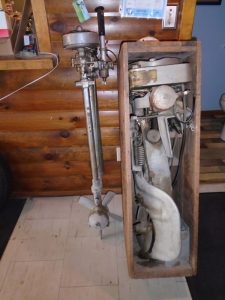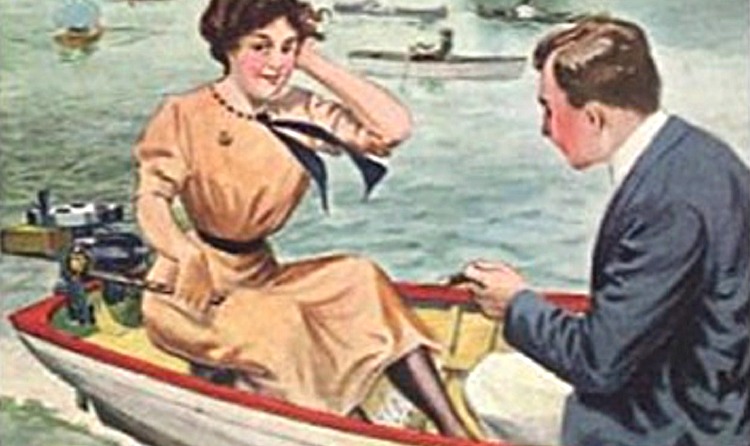OLE EVINRUDE (1877-1934)
On a hot August day in the early 1900’s Ole Evinrude, Bessie Cary and friends were enjoying a picnic on Wisconsin’s Okauchee Lake, west of Milwaukee. Miss Cary craved some refreshing ice cream on such a hot day. Mr. Evinrude volunteered to row their boat to the ice cream store, “Schatz’s”. By the time he returned the ice cream had transformed into ice cream soup. In addition to sparking a romance with Miss Cary (they married a few months later in 1906) that soup inspired Evinrude to develop an outboard motor for row boats. One that wouldn’t require bulky batteries, weigh too much, would be dependable and fast enough to prevent ice cream soup.
Born in 1877, Ole Evinrude emigrated from Norway, at the age of 5, with his family eventually settling on a farm in central Wisconsin. Like a magnet, Evinrude was attracted to all things mechanical. In his late teens he moved to Madison, capital city of Wisconsin, and became an apprentice in a farm machinery shop.
From Madison he moved to the steel town (Pittsburgh) then Chicago eventually returning to Milwaukee. The internal combustion engine was coming into its own and Evinrude, with a partner, formed the Motor Car Power Equipment Company. They manufactured a standardized motor that could be installed in any horseless carriage. Bessie Cary became the company’s office manager.
In 1907 Evinrude designed and built the first prototype outboard motor. This “coffee grinder”, so called by Bess Cary Evinrude, moved a boat through the water better than any competitor.

More the inventor than business man Evinrude failed to see the commercial possibilities. Fortunately Bess did. At her urging Evinrude built ten, then twenty, finally twenty-five “coffee grinders.” In 1909 the Motor Car Power Equipment Co. became history. The Evinrude Motor Co. was about to usher in the modern world of recreational boating. Ole and Bess complimented each other. His place was in the factory where he designed, supervised and built while Bess remained at home in the office ‘keeping’ the books and managing sales. In 1911 her ad campaign was so successful that the Evinrude Company had to find new larger manufacturing facilities.
By 1914 the Evinrude outboard company employed more than 300 workers due to sales throughout the U.S. and Europe.
Due to Bess’ failing health, Ole sold the company in 1914 so he could devote himself to caring for Bess.
Companies such as Caille, Koban and Arrow and Lockwood-Ash entered the competitive market. All used the basic Evinrude design.
When selling the original Evinrude company in 1914 in order to care for his ailing wife Ole Evinrude agreed to remain apart from the outboard business for five years. While Bess’s health improved Evinrude “mind designed” his second generation outboard – one with two cylinders instead of just one yet would weigh 50% less and produce 50% more power.
In 1921, with a grade 3 education backing him up, Ole started the Elto Outboard Motor Company (Evinrude Light Twin Outboard). During WW1 aluminum became popular and Evinrude used it for his first outboard thus reducing its weight to 47 pounds. It also doubled the output to 3 h.p. Elto innovations included a waterproof ignition system, a water-scoop cooling system, auxiliary gas tank and remote outboard steering. In 1928 Elto introduced the four-cylinder outboard motor (the Elto Quad) to meet the demand for more power, more speed. It was the first company to completely enclose the power head in a water-resistant motor cover. As with some other companies it introduced the electric start in 1930. In 1932 Evinrude introduced a rubber mounting system to isolate the power head for less vibration and smoother running.
In 1928 Briggs & Stratton Corp. acquired the original Evinrude Company which had been sold and bought numerous times since 1914. In 1929 Evinrude, Elto and Lockwood-Ash merged to for the Outboard Motor Corp.
Bess’ health once again began to fail and she passed in Milwaukee in 1933. In 1934 Ole Evinrude suddenly died at the age of 57. Their only child, Ralph, had joined the business after two years at the University of Wisconsin and he carried on with the company.
In 1935 OMC purchased the other major outboard company in the U.S. Johnson Motors of Waukegan, Illinois and formed the Outboard Marine and Manufacturing Co., with Ralph Evinrude, President. It became known as the Outboard Marine Corporation, one of America’s largest corporations with sales exceeding $700 million employing more than 10,000. Just imagine it was all inspired by ice cream at a picnic.
Some Personal Anecdotal Notes
Evinrude’s outboard motor started easily; ran beautifully. One Sunday he lent it to a friend who, when returning the motor, included orders for ten saying that it created quite a stir at Pewaukee Lake. Evinrude’s success stimulated others to develop outboard motors and Evinrude never consciously copied others but he didn’t mind if others copied him. He and Bess believed whoever did the best job would prosper. He helped any competitor who asked. They survived the Great Depression with factory sales of old stock and spare parts while competitors faded away which of course benefited the employees. From 1930 until his untimely death Ole Evinrude drew no salary which played a significant role in the company’s survival.
Currently
On May 28, 2020 Bombardier Recreational Products (BRP) announced that it was immediately shutting down production of the venerable Evinrude outboard engines in order to focus on its other marine endeavors. The Evinrude engine was invented by Ole Evinrude in 1907, and they had been built in Wisconsin since then. BRP acquired the company in 2001.
OMC made and sold boats, engines and marine accessories under
several brand names, including Chris-Craft, Lowe and Evinrude. OMC
held an estimated 32 percent share of the U.S. outboard engine
market as of December 31, 2019. BRP wanted to focus on development of other marine endeavors and products such as the company’s boat building operations (Alumacraft, Manitou, Quintrex, Stacer, Telwater, and Savage boats) and new marine innovations such as the Ghost Propulsion System.
BRP said that it fully intended to continue supporting customers and dealers with parts, and the company would fully honor new-engine warranties. Mercury Marine was to supply engine packages on BRP-built boats going forward. BRP, based in Valcourt, Quebec, had annual sales of about $6.1 billion in more than 120 countries. (2020).
For more informative reading use your favourite search engine and check out the North American Antique Outboard Motor Club (AOMC) and the Ontario-based Maple Leaf Chapter. (see featured photo)
The Elto outboard motor, on the right side in the photo, was taken by the author at Tucker’s Marine, Apsley, Ontario. It remains in its original box.
